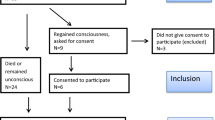Abstract
In anesthesia and critical care, invasive arterial blood pressure monitoring is the gold standard against which other methods of monitoring are compared. In this assessment of the Philips MP90 monitor, the objective was to determine whether or not oscillometric measurements were within the accuracy standards set by the Association for the Advancement of Medical Instrumentation (AAMI) and the British Hypertension Society (BHS). Three hundred and one invasive and noninvasive paired measurements were obtained from eleven adult patients on the neurosurgical service at Stanford University Medical Center. Bland–Altman plots were created to assess agreement between the two measurement systems. Paired correlation analysis, bias and precision calculations were performed. Oscillometric blood pressure measurements correlated with arterial measurements yielding Pearson r values of 0.68, 0.67 and 0.62 for systolic, diastolic and mean pressures, respectively (P < 0.01.) Mean differences with 95% confidence intervals were −3.8 mmHg ± 13.6, −2.4 mmHg ± 10.0, and 4.0 mmHg ± 13.1 for systolic, diastolic and mean pressures, respectively. The mean difference for these measurements was ≤5 mmHg as stipulated by the AAMI guidelines, but the standard deviation was greater than the 8 mmHg allowed by the AAMI guidelines. When the BHS guidelines were applied, the device merited a grade “D” for systolic and mean arterial pressure, and a grade “C” for diastolic pressure, with the highest possible grade level being “A.” There was a poor correlation between noninvasive and invasive measurements of arterial blood pressure as measured with a cuff and radial arterial cannula using the Philips MP90 monitor. These inaccuracies could lead to unnecessary interventions, or lack of appropriate interventions in anesthetic management. Further study is needed to specify the absolute inaccuracy of the monitor, and to determine if accuracy between the two methods varies with patient co-morbidities, surgical procedures, or anesthetic management.
Similar content being viewed by others
References
American Society of Anesthesiologists. ASA standards, guidelines and statements; standards for basic anesthesia monitoring: ASA (2005). http://www.asahq.org/publicationsAndServices/sgstoc.htm.
Stolt M, Sjönell G, Aström H, Hansson L. Factors affecting the validity of the standard blood pressure cuff. Clin Physiol. 1993;13(6):611–20.
Moskowitz DM, Reitz DL. Hemodynamic Monitoring. Anesthesiol Clin N Am. 1997;15(1):15–36.
Green M, Paulus DA, Roan VP, Van der Aa J. Comparison between oscillometric and invasive blood pressure monitoring during cardiac surgery. Int J Clin Monit Comput. 1984;1(1):21–6.
Gabriel A, Lindblad LE, Angleryd C. Non-invasive vs. invasive beat-to-beat monitoring of blood pressure. Clin Physiol. 1992;12(2):229–35.
Rutten AJ, Ilsley AH, Skowronski GA, Runciman WB. A comparative study of the measurement of mean arterial blood pressure using automatic oscillometers, arterial cannulation and auscultation. Anaesth Intensive Care. 1986;14(1):58–65.
Francke A, Wachsmuth H. How accurate is invasive blood pressure determination with fluid-filled pressure line systems? Anaesthesiol Reanim. 2000;25(2):46–54.
Association for the Advancement of Medical Instrumentation. American National Standard. Manual, electronic or automated sphygmomanometers ANSI/AAMI SP10-2002/A1. 3330 Washington Boulevard, Suite 400, Arlington, VA 22201-4598, USA: AAMI; 2003.
O’Brien E, Petrie J, Littler WA, de Swiet M, Padfield PL, Altman D, et al. The British Hypertension Society Protocol for the evaluation of blood pressure measuring devices. J Hypertens. 1993;11(Suppl 2):S43–63.
O’Brien E, Petrie J, Littler WA, de Swiet M, Padfield PL, Altman D, et al. Short report. An outline of the British Hypertension Society Protocol for the evaluation of blood pressure measuring devices. J Hypertens. 1993;11:677–9.
O’Brien E, Waeber B, Parati G, Staessen J, Myers M. Blood pressure measuring devices: recommendations of the European Society of Hypertension. BMJ. 2001;322:531–6.
O’Brien E. State of the market for devices for blood pressure measurement. Blood Press Monit. 2001;6(6):281–6.
Chemla D, Teboul JL, Richard C. Noninvasive assessment of arterial pressure. Curr Opin Crit Care. 2008;14(3):317–21.
Manios E, Vemmos K, Tsivgoulis G, Barlas G, Koroboki E, Spengos K, et al. Comparison of noninvasive oscillometric and intra-arterial blood pressure measurements in hyperacute stroke. Blood Press Monit. 2007;12(3):149–56.
Amoore JN, Lemesre Y, Murray IC, Mieke S, King ST, Smith FE, et al. Automatic blood pressure measurement: the oscillometric waveform shape is a potential contributor to differences between oscillometric and auscultatory pressure measurements. J Hypertens. 2008;26(1):35–43.
Amoore JN, Vacher E, Murray IC, Mieke S, King ST, Smith FE, et al. Effect of the shapes of the oscillometric pulse amplitude envelopes and their characteristic ratios on the differences between auscultatory and oscillometric blood pressure measurements. Blood Press Monit. 2007;12(5):297–305.
O’Brien E, Pickering T, Asmar R, Myers M, Parati G, Staessen J, Mengden T, Imai Y, Waeber B, Palatini P with the statistical assistance of Atkins N and Gerin W on behalf of the Working Group on Blood Pressure Monitoring of the European Society of Hypertension. International protocol for validation of blood pressure measuring devices in adults. Blood Press Monit 2002; 7: 3–17.
Author information
Authors and Affiliations
Corresponding author
Additional information
Mireles SA, Jaffe RA, Drover DR, Brock-Utne JG. A poor correlation exists between oscillometric and radial arterial blood pressure as measured by the Philips MP90 monitor.
Rights and permissions
About this article
Cite this article
Mireles, S.A., Jaffe, R.A., Drover, D.R. et al. A poor correlation exists between oscillometric and radial arterial blood pressure as measured by the Philips MP90 monitor. J Clin Monit Comput 23, 169–174 (2009). https://doi.org/10.1007/s10877-009-9178-8
Received:
Accepted:
Published:
Issue Date:
DOI: https://doi.org/10.1007/s10877-009-9178-8




